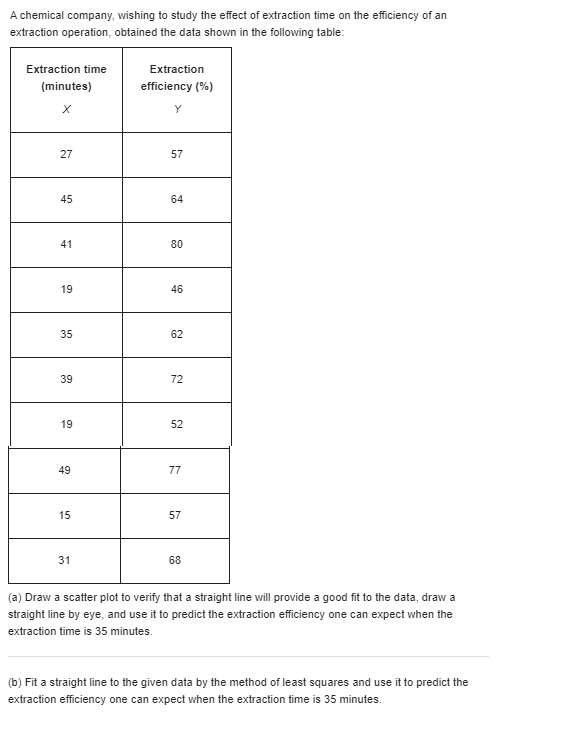


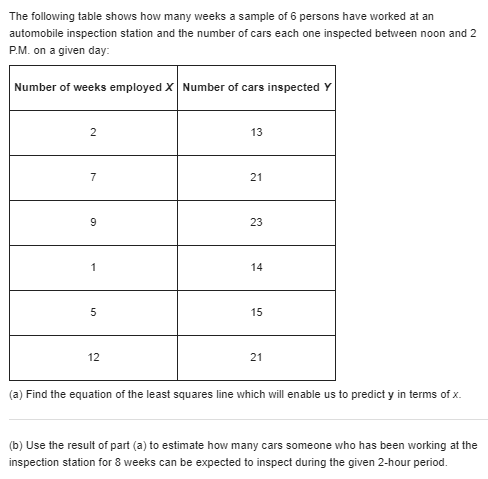
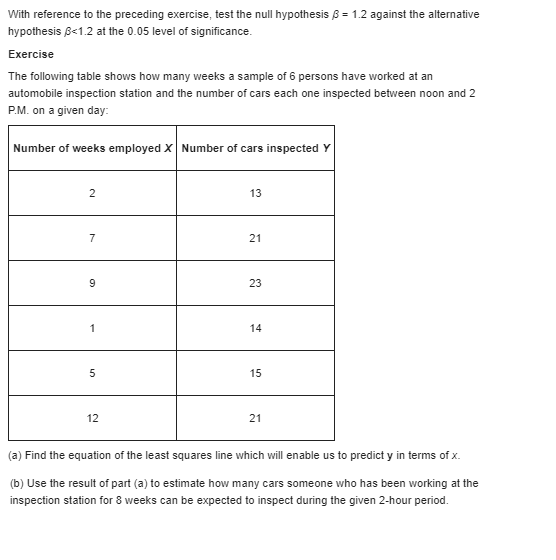
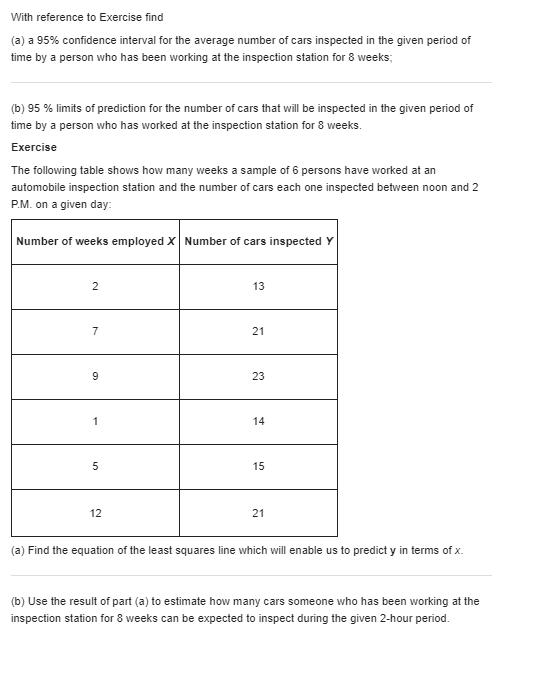
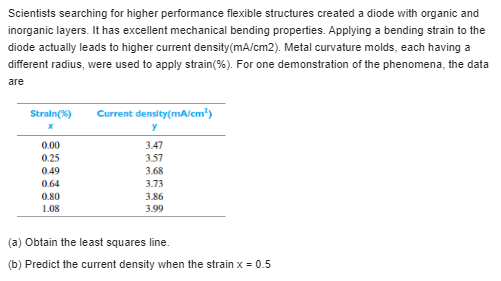
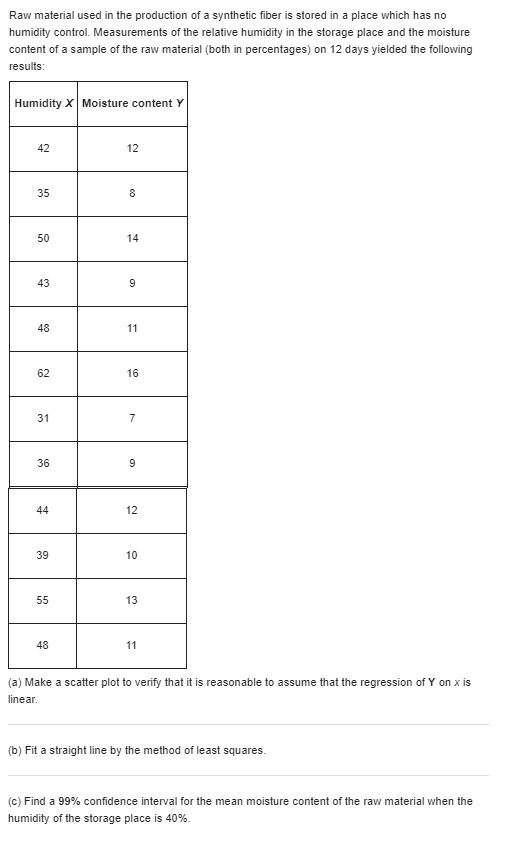
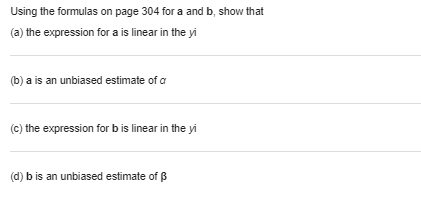
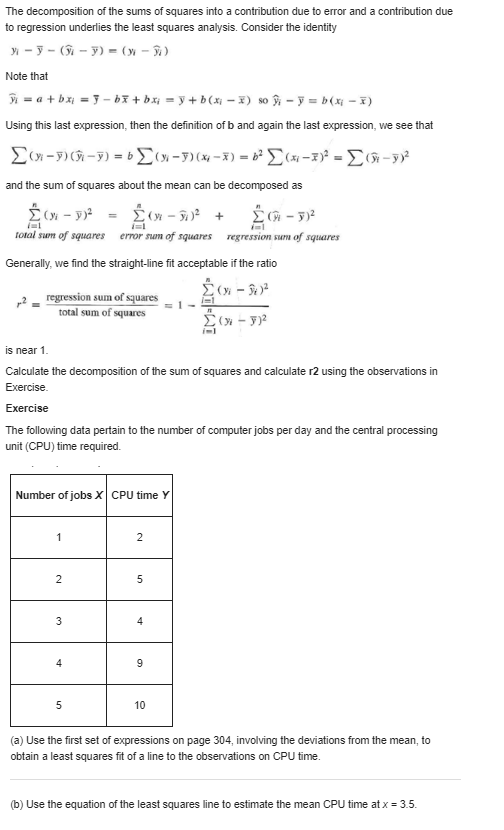

I am very thankfull to you:-.
From the given information, the sum of the x values is equal to zero, the calculation of the coefficients of the regression line of Y on x is greatly simplified; in fact, their estimates are given by a = Zy and b = (a) The percent of acid solution and their corresponding lead residue are shown in the below table Acid solution percent Lead residue 0.2 4.6 0.4 4.0 0.6 3.3 08 3.6 10 3.0 12 24 1.4 1.6 The least square line to estimate lead residue using MINITAB is as follows: Step 1: Enter the values of Acid solution percent and Lead residue in MINITAB worksheet. Step 2: Go to StatRegressionRegression Step 3: Double click on Lead residue to shift it into Response and double click on Acid solution percent to shift it into Predictor. Step 4: Click OK Then the MINITAB will display the output as follows The regression equation is Lead residue = 5.00 - 2.23 Acid solution percent Predictor Coef SE Coef I P Constant 0.2473 20.22 0.000 Acid solution percent -2.2321 0.2765 -8.07 3 = 0. 292648 R-Sq = 92.9% R-3q(adj) = 91.4% Analysis of Variance Source JE MS Regression 5.5804 5. 5804 65.16 0.000 Residual Error 0. 4282 0.0856 From the above output, the least square line is, Lead Residue = 5-2.23Acid solution percent The estimated Lead residue when acid solution percent is 1.3 is, Lead Residue = 5-2.23(1.3) =5-2.899 2 2.1 (b The estimated Lead residue when acid solution percent is 1.6 is, Lead Residue = 5-2.23(1.6) =5-3.568 = 1.4 The modified table after adding the two percent's is Acid solution percent Lead residue 0.2 4.6 4.0 06 3.3 0.8 3.6 3.0 1.3 2.1 2.4 1.4 16 1.6 1.4 The least square line to estimate lead residue using MINITAB is as follows: Step 1: Enter the values of Acid solution percent and Lead residue in MINITAB worksheet. Step 2: Go to StatRegressionRegression Step 3: Double click on Lead residue to shift it into Response and double click on Acid solution percent to shift it into Predictor. Step 4: Click OK. Then the MINITAB will display the output as follows: Regression Analysis: Lead residue versus Acid solution percent The regression equation is Lead residue - 5.01 - 2.24 Acid solution percent Predictor Coef SE Coef Constant 5.0064 0.1918 26.10 0.000 Acid solution percent -2.2421 0.1833 -12.23 0.000 S - D.247494 R-Sq - 95.58 R-Sq(adj) - 94.9% Analysis of Variance Source 55 MS Regression 1 9.1601 9.1601 149.54 0.000 Residual Error 7 0. 4288 0.0613 Total 8 9.5889 From the above output, the modified least square line is, Lead Residue = 5.01-2.24Acid solution percentAn engineer found that by including small amounts of compound in rechargeable batteries for portable computers, she could extend their lifetimes. She experimented with different amounts of the additive and the data are Amount of additive | Life (hours) 0 2 4 3 7 4 9 (a) Obtain the least squares fit of a straight line to the amount of additive. (b) Test whether or not the slope B = 0. Take a = 0.10 as your level of significance. (c) Give a point estimate of the mean battery life when the amount of additive is 12. (d) What additional danger is there when using your estimate in part (c)? (e) How would you randomize in this experiment?With reference to the preceding exercise, find 95 % limits of prediction for the moisture content of the raw material when the humidity of the storage place is 40%. Also indicate to what extent the width of the interval is affected by the size of the sample and to what extent it is affected by the inherent variability of the data. Exercise Raw material used in the production of a synthetic fiber is stored in a place which has no humidity control. Measurements of the relative humidity in the storage place and the moisture content of a sample of the raw material (both in percentages) on 12 days yielded the following results: Humidity X |Moisture content Y 42 12 35 8 50 14 43 9 48 11 62 16 31 7 36 9 44 12 39 10 55 13 48 11 (a) Make a scatter plot to verify that it is reasonable to assume that the regression of Y on x is linear. (b) Fit a straight line by the method of least squares. (c) Find a 99% confidence interval for the mean moisture content of the raw material when the humidity of the storage place is 40%.With reference to Exercise express 95% limits of prediction for the extraction efficiency in terms of the extraction time x0. Choosing suitable values of x0, sketch graphs of the loci of the upper and lower limits of prediction on the diagram of part (a) of Exercise. Note that since any two sets of limits of prediction obtained from these bands are dependent, they should be used only once for a single extraction time x0. Exercise A chemical company, wishing to study the effect of extraction time on the efficiency of an extraction operation, obtained the data shown in the following table: Extraction time Extraction (minutes) X efficiency (%) Y 27 57 45 64 41 80 19 46 35 62 39 72 19 52 49 77 15 57 31 68 (a) Draw a scatter plot to verify that a straight line will provide a good fit to the data, draw a straight line by eye, and use it to predict the extraction efficiency one can expect when the extraction time is 35 minutes. (b) Fit a straight line to the given data by the method of least squares and use it to predict the extraction efficiency one can expect when the extraction time is 35 minutes.A chemical company, wishing to study the effect of extraction time on the efficiency of an extraction operation, obtained the data shown in the following table: Extraction time Extraction (minutes) efficiency (%) X Y 27 57 45 64 41 80 19 46 35 62 39 72 19 52 49 77 15 57 31 68 (a) Draw a scatter plot to verify that a straight line will provide a good fit to the data, draw a straight line by eye, and use it to predict the extraction efficiency one can expect when the extraction time is 35 minutes. (b) Fit a straight line to the given data by the method of least squares and use it to predict the extraction efficiency one can expect when the extraction time is 35 minutes.\fWith reference to the preceding exercise, (a) construct a 95% confidence interval for 8, the elongation per thousand pounds of tensile stress; (b) find 95% limits of prediction for the elongation of a specimen with x = 3.5 thousand pounds. Exercise In the accompanying table, x is the tensile force applied to a steel specimen in thousands of pounds, and y is the resulting elongation in thousandths of an inch: X 2 3 4 5 6 y 14 33 40 63 76 85 (a) Graph the data to verify that it is reasonable to assume that the regression of Y on x is linear. (b) Find the equation of the least squares line, and use it to predict the elongation when the tensile force is 3.5 thousand pounds.The following table shows how many weeks a sample of 6 persons have worked at an automobile inspection station and the number of cars each one inspected between noon and 2 P.M. on a given day: Number of weeks employed X| Number of cars inspected Y 2 13 21 CO 23 14 5 15 12 21 (a) Find the equation of the least squares line which will enable us to predict y in terms of x. (b) Use the result of part (a) to estimate how many cars someone who has been working at the inspection station for 8 weeks can be expected to inspect during the given 2-hour period.With reference to the preceding exercise, test the null hypothesis 8 = 1.2 against the alternative hypothesis 8) Note that H=atbx = ] - bx+ bx = y+ b(x - X) 80 # - J = b(x -x) Using this last expression, then the definition of b and again the last expression, we see that and the sum of squares about the mean can be decomposed as total sum of squares error sum of squares regression rim of squares Generally, we find the straight-line fit acceptable if the ratio regression sum of squares =1 - total sum of squares is near 1. Calculate the decomposition of the sum of squares and calculate r2 using the observations in Exercise. Exercise The following data pertain to the number of computer jobs per day and the central processing unit (CPU) time required. Number of jobs X| CPU time Y N 2 5 4 4 9 5 10 (a) Use the first set of expressions on page 304, involving the deviations from the mean, to obtain a least squares fit of a line to the observations on CPU time. (b) Use the equation of the least squares line to estimate the mean CPU time at x = 3.5.It is tedious to perform a least squares analysis without using a computer. We illustrate here a computer-based analysis using the MINITAB package. The observations on page 318 are entered in C1 and C2 of the worksheet. DATA 11-22.DAT 0 2 2 4 4 5 6 y: 25 20 30 40 45 50 50 We first obtain the scatter plot to see if a straight-line pattern is evident. Dialog box: Graph > Scatterplot. Click on Simple. Click OK. Type C2 in Y column and Type Cl in X column. Click OK. Then Dialog box: Stat > Regression > Regression > Fit Regression model Type C2 in Response. Type CI in Continuous predictors. Click OK. produces the output Analysis of Variance Source DE MS F-Value P-Value Rograssion 1080.00 1080.00 24.00 0. 0 03 Error 270.00 45.00 Total 1350.00 Modal Summary R-D4 6. 70820 80.008 Coefficients Tern COAT SE COAT T-Value P-Value Constant 22. DO 4.37 5.03 0.002 X 6. 00 1.22 4.90 0.003 After the first two steps above and before you Click OK, Click Graphs. Choose Four in one. Click OK This will produce the three graphs that we introduce later for checking the assumptions Versus fits 10 5 Residual Fitted value Histogram Versus order 2.0- 10 - 1.5 - 5 - Residual Frequency 0.5- 0.0 75 -3.0 -25 00 25 5.0 75 Residual Observation order (a) One further run with 3.5% of the new component produced the cooling rate 42. Obtain the regression equation using all 9 cases. (b) Referring to your computer output, identify the decomposition of sums of squares given as the analysis of variance


































